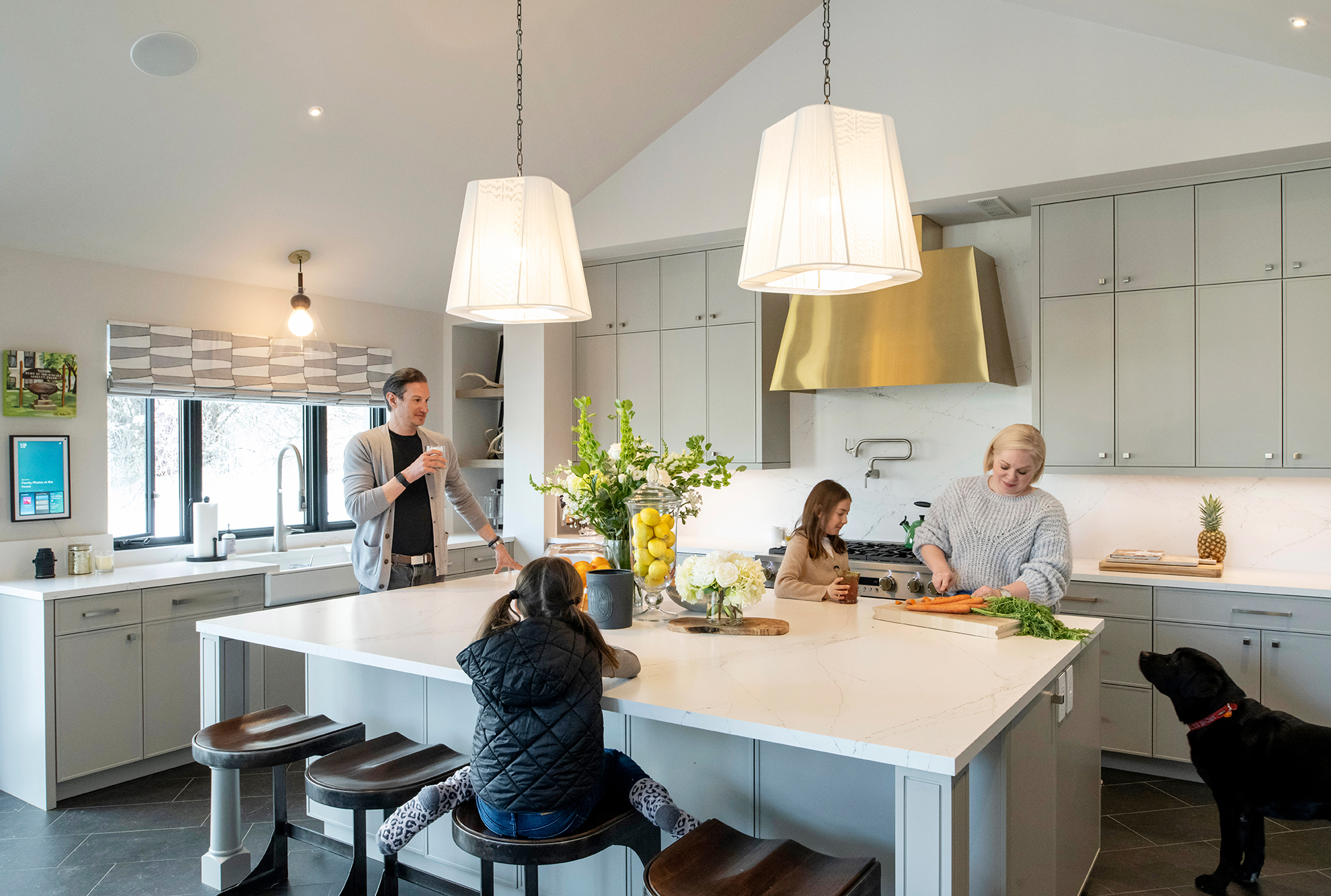Focus on mental and physical wellness came to the fore shortly after COVID-19 emerged. Renewed discussions about home health naturally intertwined themselves with conversations about sustainability and environmental responsibility. Two years later, American homeowners continue to prioritize interiors that support their mental and physical wellbeing while respecting our planet and its finite resources. With the rise of distance learning and remote work, both children and adults are still spending more time at home than before the pandemic. As such, creating healthy spaces that support each person’s needs is absolutely vital. At Laura U Design Collective, we take a wholistic approach to family-friendly design that promotes wellness in each and every corner of the home. In this post, we list our top ten tips when designing for wellness. From updating your kitchen, so it serves every family member to reinforcing connections with nature, here are a few ways we design for wellness.
Why Family-Friendly Design that Promotes Wellness Matters
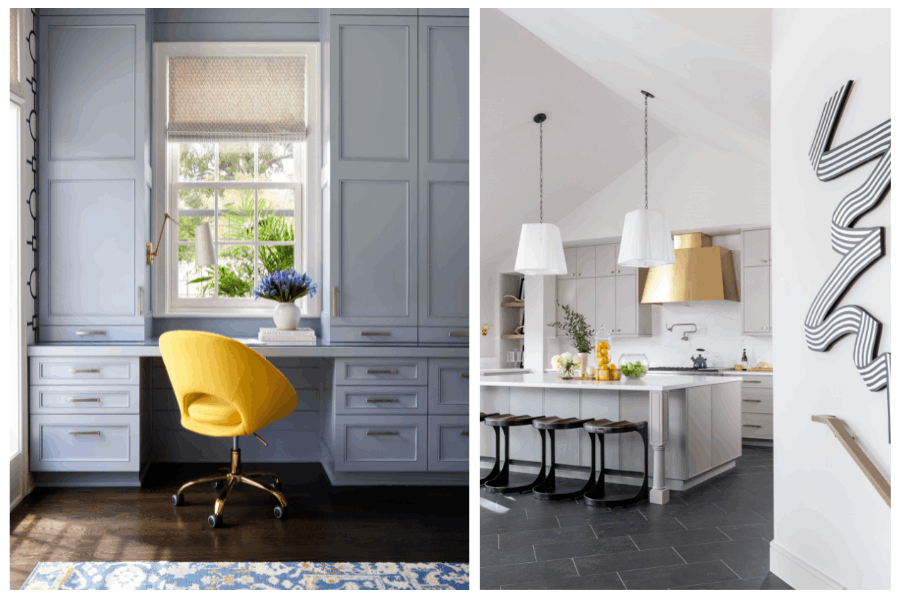
For centuries, we have considered the impact of interior and residential building design on our mental, physical and spiritual well-being. After all, there are records of feng shui dated to the 9th century BC. For those unfamiliar, feng shui is a Chinese design practice dedicated to achieving balance and harmony between nature and the built environment.
Of course, we have seen numerous technological advancements in product design, industrial chemistry, shipping and manufacturing since feng shui was first documented. Many of these advancements have occurred within our lifetimes — making home decor, furniture and building materials less expensive and more widely available. Unfortunately, they have also filled our homes with poorly-constructed furniture and dangerous chemicals.
In an article for What Works Wellbeing, Assael Architecture’s Ben Channon explains how our homes impact both mental and physical wellbeing. Channon writes that even before pandemic lockdowns, “we spent between 80 to 90% indoors with about two-thirds of that time spent at home.” Today, many of us work from home — and some of our children learn from home too. The effects of our interiors go far beyond the physical damage wrought by off-gassing furniture and building materials. Natural light helps regulate our sleep, colors recall pleasant memories, specific scents calm our minds and organized interiors create a sense of order.
Homeowners Remain Committed to Designing for Wellness
During the COVID-19 pandemic, many families reconsidered the ways in which we design, decorate and utilize our homes. Health, safety and sustainability shot to the forefront of our minds and to the top of our to-do lists.
For a while, Sick Building Syndrome was on everyone’s lips. A Chelsea Group survey from early 2021 found “70% of Americans are concerned [about the impact of IAQ] on the health of their families.” Sustainability is another continuing concern. Reporting on the results of a Genomatica survey in a Forbes article, John Cumbers notes “85% of Americans” are concerned about sustainability. According to Cumbers, “‘sustainability has moved from a fringe preference into a core imperative across American life.’”
Of course, it is important to note that not all of us have access to stable, affordable, high-quality housing. Improving access to such housing comes first, but finding ways to make each home healthier and its inhabitants happier is not far behind. Below, we offer our tips for creating a happy, healthy home that supports your family while achieving harmony with the natural world.
Designing for Wellness: Our Top Ten Tips
#1 Update Kitchens for Enhanced Accessibility
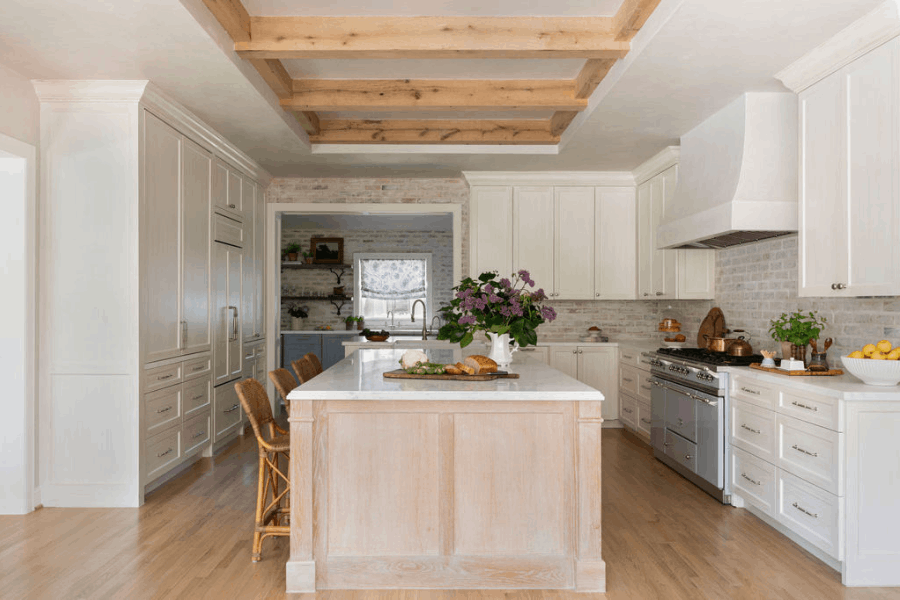
The kitchen is the heart of the home for many families, so everyone should be able to use it and enjoy doing so. One key to designing your kitchen for wellness is to pay particular attention to accessibility. In this recent post about kitchen renovations, we underscore the value of universal design in shared spaces. Universal design improves access for the elderly, children, people with disabilities and those with dietary restrictions or other health concerns.
You can make your kitchen more accessible by “updating the lighting, lowering countertops, motorizing window treatments, and widening walkways.” One might also elevate appliances to avoid bending down or to create space for wheelchair users. In our Hedwig Village project, we added a lift-up, pull-out shelf to one of the base kitchen cabinets. This shelf allows our clients to easily access the mixer they wanted to store away instead of keeping on the counter.
Organization is also key. Add a day pantry, butler’s pantry or other storage to ensure there is a place for everything. Consider storing appliances used by family members with dietary restrictions, allergies or other health concerns separately to avoid cross-contamination. Be sure to integrate such appliances — i.e. by creating a smoothie station or other prep area — to avoid isolating those family members. After all, the goal is to create a kitchen that promotes healthy eating and active participation from all family members.
#2 Offer Kids Separate Study Spaces Where They Can Learn and Problem-Solve
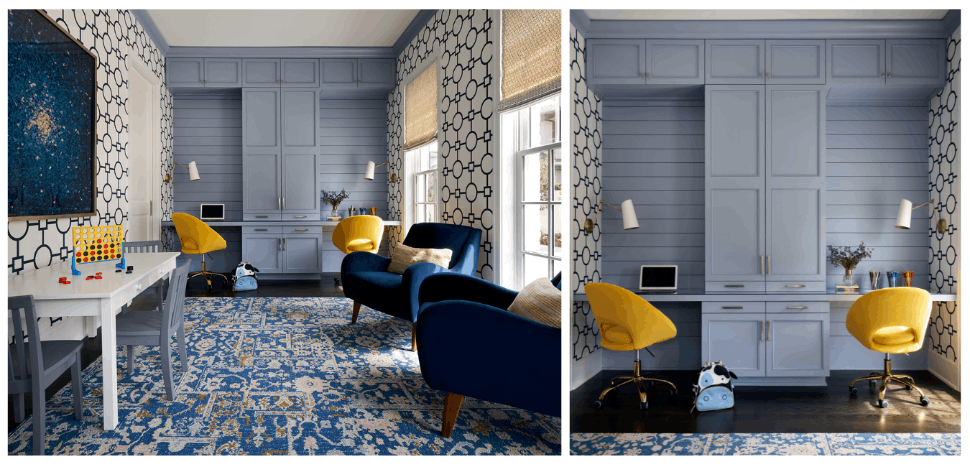
Like adults who work from home, children need their own space in which to learn, problem solve and pursue independent study. We recommend offering kids their own “offices” in which to complete homework or attend school from home. Encourage your kids to participate in the design process, so they feel more inclined to use the study space.
#3 Create Activity Rooms That Inspire Kids and Reinforce Healthy Habits
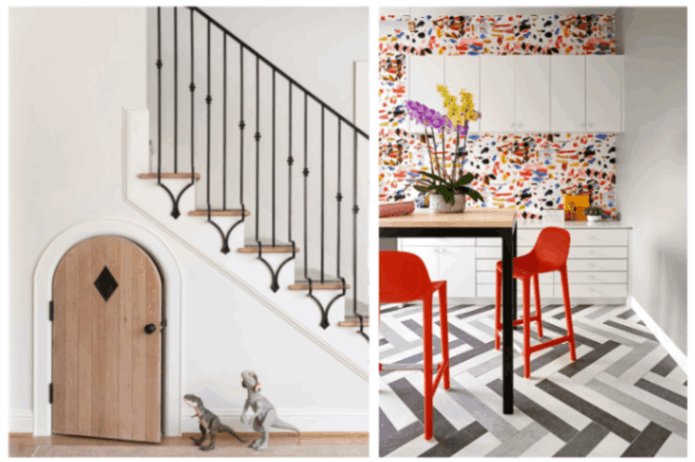
Children can benefit from a separate study space, but they need work-life balance just like adults do! In addition to a kids’ study, consider creating activity rooms that inspire kids and help them create healthy habits. Take advantage of unusual spaces like the under-stair nook pictured above.
As part of our Hedwig Village project, LUDC Creative Director Gina Elkins found the perfect way to utilize that awkward space beneath the stairs. Gina sketched the doorway pictured above right onto the wall during a sight visit. Perfectly sized for our clients’ little girl, this stair nook is her gateway into an entire world of imaginative play.
Try to cater to their interests as well. In “How to Design Functional and Chic Playrooms,” we note “centering a playroom around hobbies and pastimes leads to more productive play-dates and gatherings.” Short on space? Not everyone has enough rooms to provide every child with their own playroom and study space. Take this opportunity to create joint spaces where the family can gather together to craft or do something creative as a group.
#4 Choose Natural, Local Materials That Reflect the Landscape
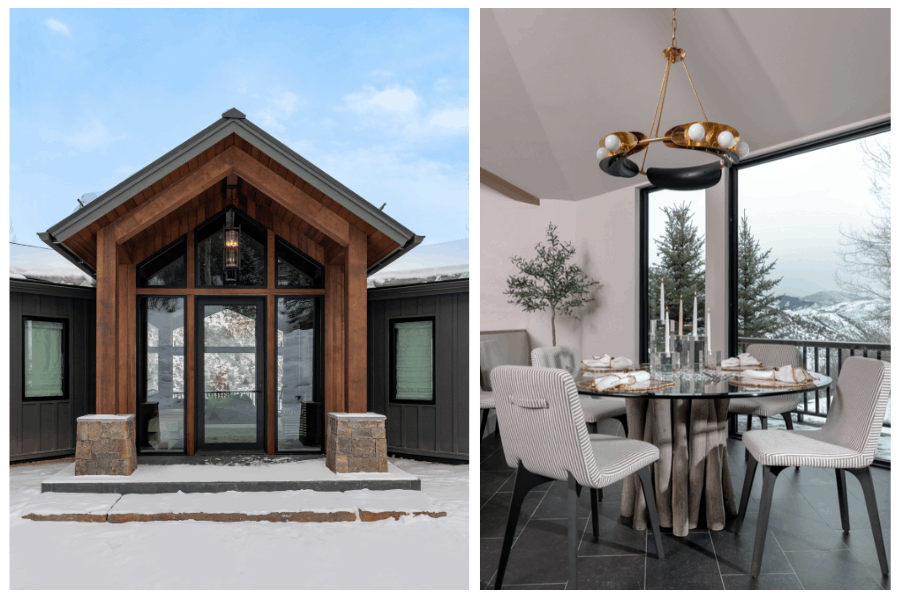
Creating spaces that are in-tune with nature is part of our shared heritage as human beings. Quoted by Jared Green in his article “The Psychology of Interior Design” for the ASLA, architect Barbara Stewart elaborates. Stewart writes that everyone from the Druids to Native Americans looked to the surrounding landscape when building. Our ancestors “‘designed structures according to nature and in tune with the natural environment.’” Green agrees, adding that “almost all civilizations have ancient forms of environmental psychology.” We would do well to consider each specific site and source locally available materials when designing modern homes too.
Natural materials not only create a healthier environment. They can also improve privacy and reduce noise. Natural materials like bamboo excel at sound absorption. A 2012 study published in Building Acoustics found that “many natural materials…show good sound absorbing performances.” Authors Francesco Asdrubali et al. write that “these materials also show good thermal insulation properties [and] are often light-weight.”
Best of all, such materials “are not harmful for human health.” We chose healthy, sustainable materials that reflect the landscape when designing our Mountain Lane Show House. The exterior and interior of MLSH are both pictured above. As we note in our post about modern mountain design, each home “should honor the surrounding landscape rather than interrupting it.”
#5 Support Year-Round Outdoor Activities with A Mud Room that Keeps Your Home Clean and Dry
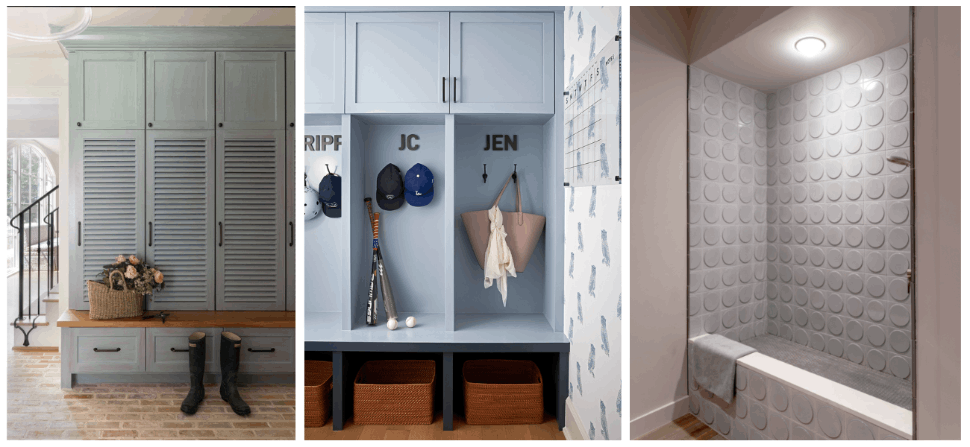
When designing for wellness, homeowners should also find ways to make outdoor activities accessible all year round. It can be difficult to get our families up and out during the chilly winter months. However, doing so is vital to our health and wellbeing. Spending time outdoors — whether hiking, skiing, swimming or simply walking around — is especially important for those who suffer from Seasonal Affective Disorder.
This resource from the Cleveland Clinic recommends “spending time outside every day” to “better manage [SAD] or even prevent it from coming back.” The Cleveland Clinic also suggest exercising at least three times each week. This is because “exercise relieves stress and anxiety, which can play a role in your SAD symptoms.”
In our Mountain Lane Show House, we designed a mudroom complete with ski lockers reclaimed from the Aspen Mountain Club. This space was designed sustainably and protects the rest of the house from muddy paws, wet clothes and dirty equipment. We even added a dog shower — pictured above on the far right. The mudrooms in our Hedwig Village and Rice Residence projects can also be viewed above.
#6 Remember That Steam Showers Aren’t Just for Athletes
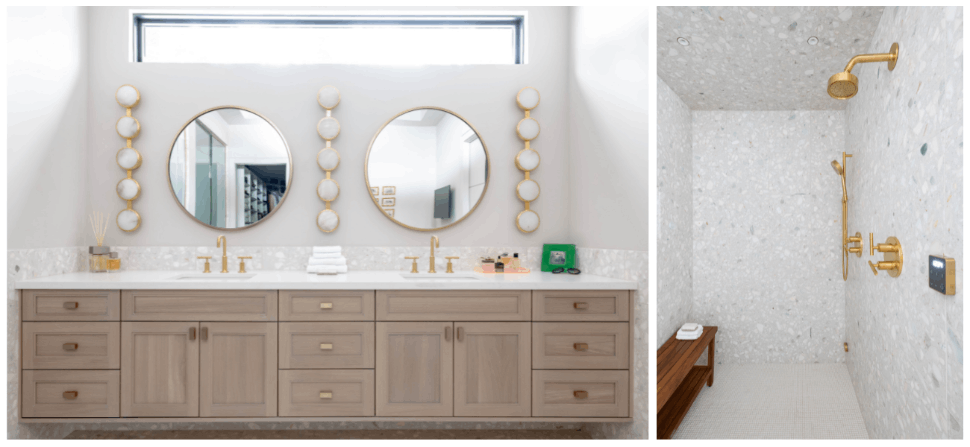
Our next tip for a family-friendly design that promotes wellness is to remember that steam showers aren’t just for athletes and aromatherapy works wonders! We installed a steam shower in the primary suite of our Mountain Lane Show House. The Kohler steam head also includes an aromatherapy well, which can help energize, relax or even clear stuffy sinuses. By adding a curated scent profile to your shower, you can book-end your day. Opt for energizing oils in the morning and calming ones in the evening. With the right essential oils, you can encourage alertness before work and support sleep at night.
According to this 2016 study, “fragrances significantly modulate the activities of different brain waves and are responsible for various states of the brain.” This study and others also point to “the beneficial use of various aromatic plants in aromatherapy.” For sleep, experts often recommend lavender, ylang ylang and chamomile oil. To improve focus or alertness, you might consider peppermint or rosemary.
#7 Embrace a Passive Approach to Heating and Cooling
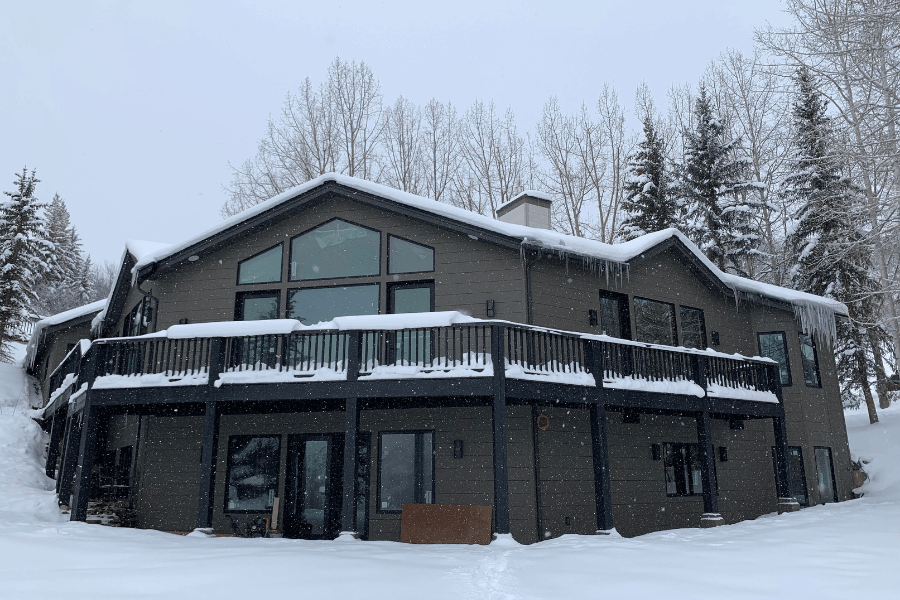
Next, we recommend embracing a passive approach when designing for wellness. This resource from NY Passive House explains passive house design “relies on a combination of energy efficiency with passive solar and internal heat gains.”
Relying on certain building materials, design choices and the site itself, passive houses limit use of electricity or natural gas when heating or cooling. Of course, not every home can be built from the ground-up or renovated to meet passive house standards.
Thankfully, there are many ways to improve your home’s energy efficiency and reduce its carbon footprint without starting from the very beginning. Our Mountain Lane Show House was remodeled to be much more sustainable. The home has no AC system. Instead, Laura and her family rely on new energy-efficient windows and doors to regulate interior temp.
#8 Create Transitions from One Space to the Next
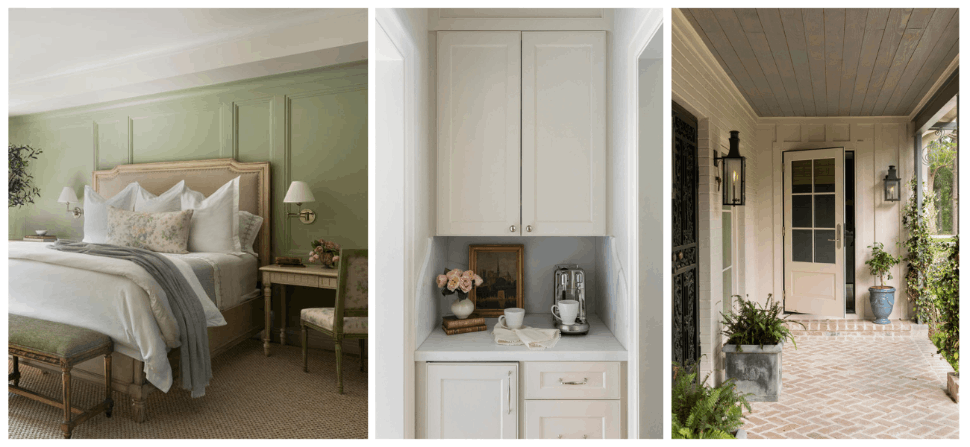
Next on our list of designing for wellness tips, we suggest creating transitional areas. By creating physical transitions from one space to the next in your home’s layout, you also help create mental transitions. This is especially important when one works from home and lacks a daily commute to mark the transition.
Try creating a mini commute by separating work spaces from sleep, relaxation and play areas. You can also mark the shift from home life to work life with meaningful moments like a cup of coffee or tea.
We accomplished this in our recent Hedwig Village project. Between the bedroom and bathroom of the primary suite, we added a small vestibule to create a certain degree of separation. The vestibule replaced the double door that separated the bath and bedroom previously. With the owner’s study just off the primary bath, a morning bar was the perfect inclusion for this vestibule.
#9 Capitalize on Views and Welcome Natural Light with Expansive Windows
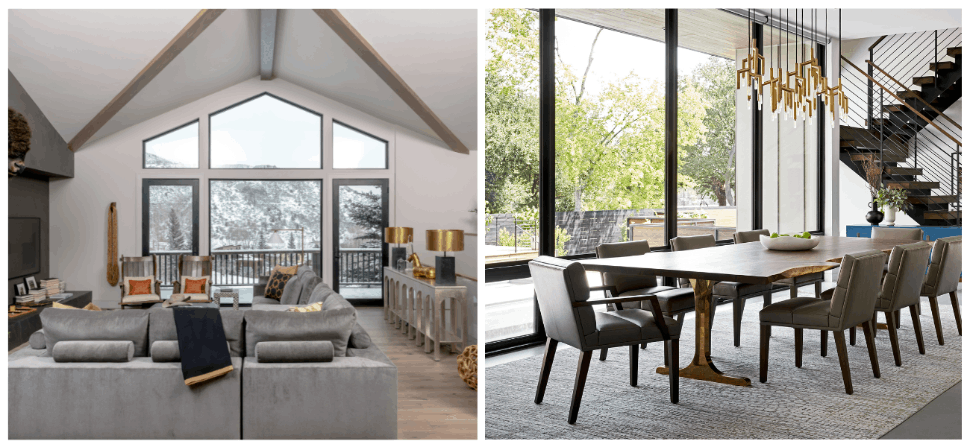
We already pointed to the power of natural light when discussing the physical and emotional impacts of our indoor environments. Natural light exposure at appropriate times can improve sleep at night and focus throughout the day. In addition to regulating certain hormones, natural light exposure can also prevent eye strain commonly incurred when using screened devices.
Expansive windows like those in our Mountain Lane Show House and Braeswood Place project not only provide natural light. They also help with ventilation and offer gorgeous views of nature. The latter could boost mental health and even improve physical wellbeing according to recent studies.
A 2013 study published in the Journal of Environmental Science & Technology provides evidence. The study spearheaded by researcher Daniel K. Brown found that “viewing nature scenes positively affects recovery of autonomic function following acute-mental stress.” If simply looking at photos of nature could help us recover from stress faster, imagine what the real thing could do!
#10 Ensure the Interior Flows Naturally to the Exterior for Easy Entertaining and a Seamless Connection to Nature
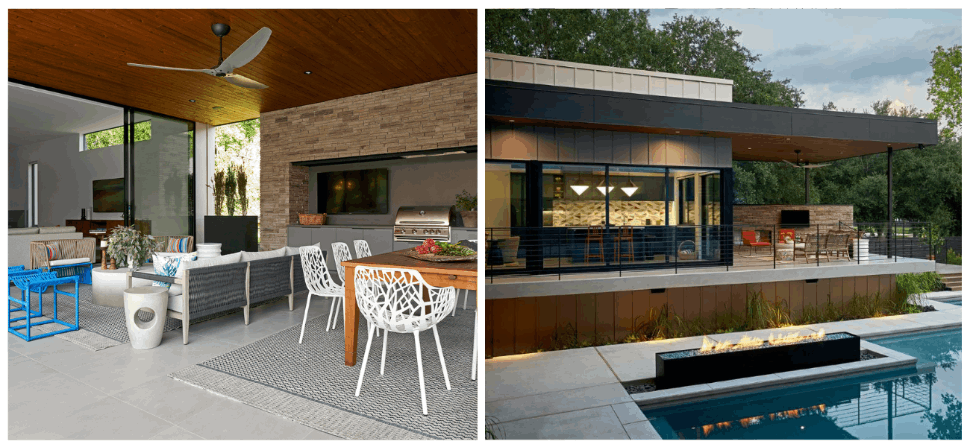
Last on our list is to ensure the interior flows naturally to the exterior for easy entertaining and a seamless connection to nature. Our Braeswood Place project is an excellent example of indoor-outdoor living. With floor-to-ceiling glass sliders, the pool, covered patio and outdoor dining are connected directly to the indoor living room. Just beyond is a pool house — complete with its own patio, kitchen and guest suite.
Who among us doesn’t enjoy the coziness of a crackling fire or savor the relief of passing from frigid porch to warm foyer? Remember that you can create subtle distinctions between the indoors and outdoors without interrupting your home’s connection to nature. There is no need to sacrifice comfort. Plus, establishing a transition from exterior to interior and vice-versa can signal an important mental and emotional shift.
At Mountain Lane, we ensured that coming into the home is a cozy, welcoming experience. Visitors pass from a foyer decorated with dark colors to a light-toned great room with tall ceilings and huge windows. Views of the Continental Divide remind one that the beauty of Aspen is all around the home. This is just one way we brought the outside indoors.
Are you hoping for a family-friendly design that promotes wellness throughout your home? Learn more about our approach to designing for wellness here.
We’d love to collaborate with you to design your dream home. Contact us below!


